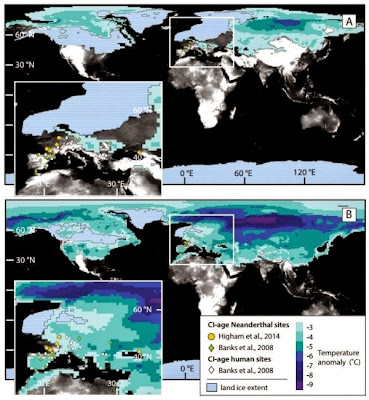A paper (A recent bottleneck of Y chromosome diversity coincides with a global change in culture, (2015) Monika Karmin et al. Published in Advance March 13, 2015, doi:10.1101/gr.186684.114 Genome Res. 2015.) suggests that the evolution of farming reduced the number of reproducing males to a minimum, and thus created a bottleneck in Y chromosome diversity as many male lineages became extinct as they could not pass on their genes (and Y chromosomes) to the next generation.
The idea is that as humans became sedentary some 10 kya, some males became dominant and accumulated wealth, power and, as expected, this gave them access to the women and excluded the other less "fit" males. The ratio reported for that period is as many as 17 women reproducing for every one man who passed on his genes.
The paper is paywalled, but the Supplementary Material is free. So I peeked at it and was surprised by the following figure (S4B):
Yes, All populations (But one) see a dip in the effective population size between 10 and 3 kya., followed by a rebound and growth. The only group to show another trend: Andean natives, whose population just steadily declines from 3 kya onwards.
First let's read the Abstract:
Abstract
It is commonly thought that human genetic diversity in non-African populations was shaped primarily by an out-of-Africa dispersal 50–100 thousand yr ago (kya). Here, we present a study of 456 geographically diverse high-coverage Y chromosome sequences, including 299 newly reported samples. Applying ancient DNA calibration, we date the Y-chromosomal most recent common ancestor (MRCA) in Africa at 254 (95% CI 192–307) kya and detect a cluster of major non-African founder haplogroups in a narrow time interval at 47–52 kya, consistent with a rapid initial colonization model of Eurasia and Oceania after the out-of-Africa bottleneck. In contrast to demographic reconstructions based on mtDNA, we infer a second strong bottleneck in Y-chromosome lineages dating to the last 10 ky. We hypothesize that this bottleneck is caused by cultural changes affecting variance of reproductive success among males.
But let's not forget that the analysis is based on saliva swabs taken from extant males around the world and the genetic data was then subjected to statistical processing which yielded an evolution of the reproductive populations both male and female.
In other words we are "guessing" how the diversity of Y chromosomes evolved over time in different regions. It is not like they sampled ancient remains and did a direct measurement. This is again, a conjecture based on statistic inferences.
In other posts I have expressed my doubts regarding these methods. Here I express them again.
The "Andeans" that were surveyed were Colla (or Kolla) who inhabit what is now Bolivia and Peru, and raised llama and alpaca camelids and grew crops of corn, potatoes, peppers, squash, tomatoes, cotton, quinoa among others. The other "Andean" group actually lived in the Chaco savanna region, a flat area that lies to the North of Argentina. They grew squash, melon.
What made these people so different from the rest of humans? An explanation is needed.
Maybe the whole dip is just a statistical artifact.
But assuming it is real. Are we to expect that the development of farming (something so labour intensive) would lead to some males prevailing over others and inseminating all available women?
Can we imagine a primitive farmer society with men gathering on average 17 women each, in harems and, obviously dispossessing the other 16 males of women with which to mate with?
How about a world that just became sedentary, with higher ratios of diseases associated to sedentary life, with naturally weaker males dying in their childhood, or later during their teens and early adulthood in inter-tribal warfare? Women, subjected to plunder and rape by the victors would bear the children of the new dominant groups while the other men became slaves with no reproductive rights...
Are we to imagine that Wichi and Colla in South America were less warlike people? or had some other tendencies?
I don't think so, and propose an alternate explanation (admitting that it is not a statistical artifact). It is very unlikely, but somehow explains the bias against men and the drop of diversity... As I wrote in my post on Neanderthal - Human admixture:
Haldane’s law [2] which states that:
“When in the offspring of two different animal species one sex is absent, rare or sterile, that sex is the heterozygous sex”
Heterozygous sex meaning the offspring with two different sex chromosomes: XY, that is, the male. In plain english Haldane is saying that a male (Neanderthal) and a female (Homo sapiens) would have had more daughters than sons (boys would be rare). These few, if any (absent) boys would be carrying their Neanderthal father’s Y (Neanderthal) chromosome and, they would be very probably sterile and therefore did not have children and could not pass on their Y chromosome to their sons.
In other words, humans and Neanderthals mixed and the male Neanderthals passed on Their Y to boys who were sterile and therefore the Y diversity was reduced (every Neanderthal mating was one less human one)...
What about the Andeans... their slump came later and continued... were there relict Neanderthals in America? By the way, look at the curves of the Central Asians and Africans, they dropped and actually, never recovered while the others did. Would this reflect a later admixture in those locations?
Patagonian Monsters - Cryptozoology, Myths & legends in Patagonia Copyright 2009-2015 by Austin Whittall ©




















